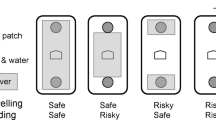Summary
A model of risk-sensitive foraging based on a continuously foraging but interruptable predator is developed and tested in a simple choice experiment using common shrews.
Given a choice of two feeding stations, shrews behaved in accordance with the broad predictions of the model. Having been trained below their estimated food requirement, shrewss preferred the station y elding the higher mean reward rate, but prefereence for a constant (constant reward rate) or risky variable reward rate) station was influenced by experience of variance in reward rate at the risky station.
Preference was influenced most clearly by experience of reward rate variance during tests rather than training.
Similar content being viewed by others
References
Barnard CJ, Brown CAJ (1985a) Risk-sensitivity in foraging common shrews (Sorex araneus L.). Behav Ecol Sociobiol 16:161–164
Barnard CJ, Brown CAJ (1985b) Competition affects risk-sensitivity in foraging shrews. Behav Ecol Sociobiol 16:379–382
Barnard CJ, Brown CAJ, Gray-Wallis J (1983) Time and energy budgets and competition in common shrews (Sorex araneus L.). Behav Ecol Sociobiol 13:13–18
Caraco T (1981) Energy budgets, risk and foraging prefernces in dark eyed juncos (Junco hyemalis). Behav Ecol Sociobiol 8:213–217
Caraco T (1982) Aspects of risk-aversion in foraging whitecrowned sparrows. Anim Behav 30:719–727
Caraco T (1983) White-crowned sparrows (Zonotrichia leucophrys): foraging preferences in a risky environment. Behav Ecol Sociobiol 12:63–69
Caraco T, Lima SL (1985) Foraging juncos: interaction of reward mean and variability. Anim Behav 33: 216–224
Caraco T, Martindale S, Whittam TS (1980) An empirical demonstration of risk-sensitive foraging preferences. Anim Behav 28:820–830
Crowcroft P (1957) The Life of the Shrew. Reinhardt, London
Houston AI, McNamara JM (1982) A sequential approach to risk-taking. Anim Behav 30:1260–1261
Houston AI, McNamara JM (1985) The choice of two prey types that minimises the probability of starvation. Behav Ecol Sociobiol 17:135–141
McNamara JM (1984) control of a diffusion by switching between two drift-diffusion coefficient pairs. SIAM J Control Optimiz 22:87–94
McNamara JM, Houston AI (1982) Short-term behaviour and life-time fitness. In: McFarland DJ (ed) Functional ontogeny. Pitman's, London
McNamara JM, Houston AI (1986) The common currency for behavioural decisions. Am Nat (in press)
Stephens DW (1981) The logic of risk-sensitive preferences. Anim Behav 29:628–629
Stephens DW, Charnov EL (1982) Optimal foraging: some simple stochastic models. Behav Ecol Sociobiol 10:251–263
Vogel P (1976) Energy consumption of European and African shrews. Acta Theriol 21:195–206
Author information
Authors and Affiliations
Rights and permissions
About this article
Cite this article
Barnard, C.J., Brown, C.A.J., Houston, A.I. et al. Rick-sensitive foraging in common shrews: an interruption model and the effects of mean and variance in reward rate. Behav Ecol Sociobiol 18, 139–146 (1985). https://doi.org/10.1007/BF00299042
Received:
Accepted:
Issue Date:
DOI: https://doi.org/10.1007/BF00299042




